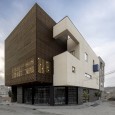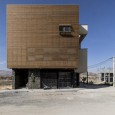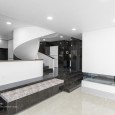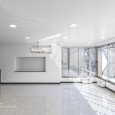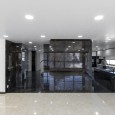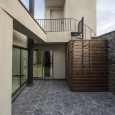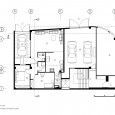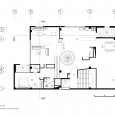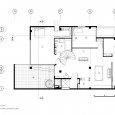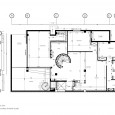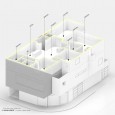Description
Collage-like superimposition of simple rectilinear blocks juxtaposing one another in a heterogeneous incoherent way based upon a new construction method in Kurdistan was aimed at creating a proper contemporaneous building paradigm.Using local constructing material, and penetrating to the interior visible spaces, we wanted to apply the local material to invoke a history of a collective folk memory, a remarkable aspect of the multicultural character of the Iranian culture, and we were not satisfied only by restricting ourselves to use the well-known material diversity to induce shallow sense of ornamentation. We wanted the Blue Cube House to emphasize other old-age houses near the site, by bringing them to the actual foreground. Stone, for us, was not solely a constructing material, but a sign of presence of our past. We were no longer concerned over their beauty or ugliness.
As a cheap and quick material, concrete is not in harmony with the contemporary architectural trends in Kurdistan. Stockpiling of the past on the present. Burden of everydayness on the memory. Two incompatible sides at the same time. A heterogeneous and self-contradicting synchronicity, and finally an attempt to attain a determinate and convulsive language, as if putting a mirror in front of the present. Blue Cube as an abruptness. An opportunity to take a deep breath despite the mist of the banality of the days. An excuse for going on, that makes its own instrument.
Whereas the Blue Cube and the void of inner life, I am the narrator of my deepest sorrows and my innermost world. Stone, concrete, and wood are the narrators of the outer world. House no. 2 is the result of interconnection between me as an architect, the people, and Jahān Fo'ād as my client. This is a sort of mutual agreement in an eternal silence. It relates the sorrows projecting inwards out, and they cohabitate but only in an absolute silence.
As Murakami1 has put it, memories are like fuel, which we incandesce to survive. For me, the Blue Cube was something like a primary step to burn the memories, only to endure the suffering. This was the confluent of profession and passion. A sign to lose beloved ones. An attempt to inhale. That void as well as the Blue Cube itself formerly was not there on the map. This is not merely an engineering matter, it delves into the moments. The moments of losing and non-existence. Afterwards it was not possible for me to practice architecture as before. I was no longer able to think about beauty as I did before. Now everything seems crystal clear to me. In architecture I sought something to endure the moments of life, and it reminds me again of Murakami: from a certain moment onwards everyday is a series of consequent losses. I did not acquire anything from the Blue Cube. It was only a reason for me to survive. Seeking immortality. It may seem nonsense, but years after my departure, when one sees the Cube, they will be reminded of my bygone presence. This is the meaning of immortality for me, and no one can escape from it. For me it is an enduring sufferance. The Blue Cube is borne when I am not anymore. Maybe years from now, maybe tomorrow.
I was a child when I took minibus from Mahābād to get to Bukān. The summer holidays was spent at the Granny's. It was a big house with labyrinthine interconnected rooms. An isolated house. We hated taking bath. We flew in the courtyard and finally were trapped and forced into the bathroom. Crying and shouting continued when a not-so-warm warm was poured on our heads. I hated that. It was an endless struggle. When we were done, we ran out to the alley to play. At noon we came back. A soft smell of food was caressing our smell. Our nanny was busy there at the kitchen. I nibbled a bit of the food, and she smiled. It was the best place of the whole house. Water was poured on the concrete floor, and the temperature dropped. The kitchen had an in-built oven, where nanny baked home-made bread. The worst place of the house turned out to be the best part of it. I always wanted everything to begin with the kitchen. One has to go up and down through the staircases and suddenly confront with the kitchen place. Wide steps should be built in a way as if you are entering an important space. I wanted the kitchen to be the center as well as the beginning of everything in design. It turned out to be an extended central space, colored in dark hue, in contrast with the flanking whitewash covering of the dining and living rooms. The round stairs at the top floor was also located inside the kitchen. If you want to reach the fireplace or to the guest section or to the lavatories you have to go across the dark kitchen. The visible void is accessible only through the kitchen. It serves as a route and as a destination. Inside the Blue Cube the kitchen is the common denominator of all other spaces. The point of participation in the whole house.
1- Haruki Murakami (born January 12, 1949) is a Japanese writer.
Farsi
Please click on the Link below to read the information in Farsi Language.
Click Here!
